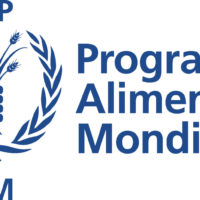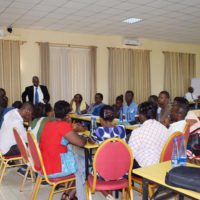Food insecurity, clinical stage, education level, professional activity, essential household income, marital status,… are some factors which lead people living with the HIV/AIDS to malnutrition.-By Diane Uwimana

Bienvenu Djossa: “The survey will enable to inform different actors on vulnerability criteria and describe malnutrition of people living with HIV/ AIDS.”©Iwacu
The prevalence of malnutrition for men and women is estimated at 28.1% and 25.0% respectively with 6.0% of severe case for the first and 5.8% for the second. This resulted from a survey conducted by the National Reference Centre in HIV /AIDS, in partnership with a Network of Burundians living with HIV/AIDS (RPB+), from March 2012 to May 2012 in 17 provinces and in different treatment sites. It was a cross-survey, multi-centric, descriptive and analytical. The respondents were people of 15 years old and over. According to Bienvenu Djossa, Representative of World Food Program, this survey will help to capitalize results through national sectors in order to bring solutions to the beneficiaries. It will also enable to inform different actors on their vulnerability criteria and describe malnutrition of people living with HIV/ AIDS. “We are confident that the results will help the good planning of different projects and programs for nutrition support especially in the National Strategic Plan (2012-2016) review which is in process. This plan will finally facilitate the implementation of the next Strategic Plan (2014-2017) which will respond to the current challenges”, indicates Djossa.
He indicates that the survey will allow the decision-makers to make their plan following the conditions of these malnourished. It is worth noting that 2286 respondents were addressed during the survey: 72.2% of women and 27.8% of men. Dr Evelyne Baramperanye, one of the researchers, mentions that women living with HIV/AIDS, in general, constitute 67%. According to her, 11.9% were women during the pregnancy and lactation period. They were between 35 and 49 years old. Female and male respondents came from both rural (59.4%) and urban (37.5%) areas. Dr Baramperanye underlines that the most vulnerable people are widows or widowers and divorced people who represent 43. 3% while married people are 39. 9%. Concerning the education level, 48.1% were illiterate. Those who have been to primary school were estimated at 41.6% while 8.1% had a secondary school level and 1.5% having higher education.
“The risk of impoverishing households”

Dr Jean Rirangira : “The survey will help the decision –makers to think about planning carefully when analyzing and reviewing the strategic plan (2012-2016) and setting up the next one (2014-2017)”.©Iwacu
The main risks having big impacts on the households are listed according to their severity: inflation affects 55.5% of households; drought has 28.8%, epidemics and diseases 18.2% and erosion caused by abundant and heavy rain 15.8%. Following the Survey Global Analysis Food Security and Vulnerability conducted in 2008 at the national level, the major risks of rendering people very poor are listed in terms of their importance: drought (65.5%), inflation or increased price (34.1%), hail damage (21.7%), insects and plant diseases (18.1%).
From the survey, food insecurity is more observed in these provinces: Ngozi (88.7%), Kayanza (83.5%), Karuzi (75.8%), Bujumbura-Rural (88.7%) and Mwaro (61%).
“Most food consumed in different families”
Most food eaten by people living with HIV/AIDS is also listed according to its importance: vegetables, oil, tubers and cereals. Concerning the animal protein food like meat, fish, eggs, milk represents a law rate in different households. Most families consume cassava (75.9%); vegetables (70.7%), maize (59.1%) and other roots and tubers (52.1%). Dr Jean Rirangira, Executive Permanent Secretary of National Commission for Fighting Against HIV/AIDS in the Ministry in Charge of Public Health, indicates that this survey will help the decision –makers to think about planning carefully, when analyzing and reviewing the strategic plan (2012-2016) and setting up the next one (2014-2017). “This will help us to search for resources and funds for our beneficiaries”, he urges
——————————————————————————————————————
Some recommendations from the survey
Ensuring food quality consumption of people living with HIV/AIDS;
Reducing food insecurity in families;
Improving care quality of HIV/AIDS patients;
Improving socio –economic situation of people living with HIV/AIDS.
——————————————————————————————————————–
According to Isidore Sindabarira, a nutritionist from ANSS and SEP/CNLS, a person living with VIH/AIDS must eat food which fulfils all required balanced food elements. “She/he must eat complete food which contains rich proteins, carbohydrates, vitamins and minerals. Otherwise, they should be fed according to their clinical stage and following different medical pieces of advice”, he says.



















 IWACU Open Data
IWACU Open Data

